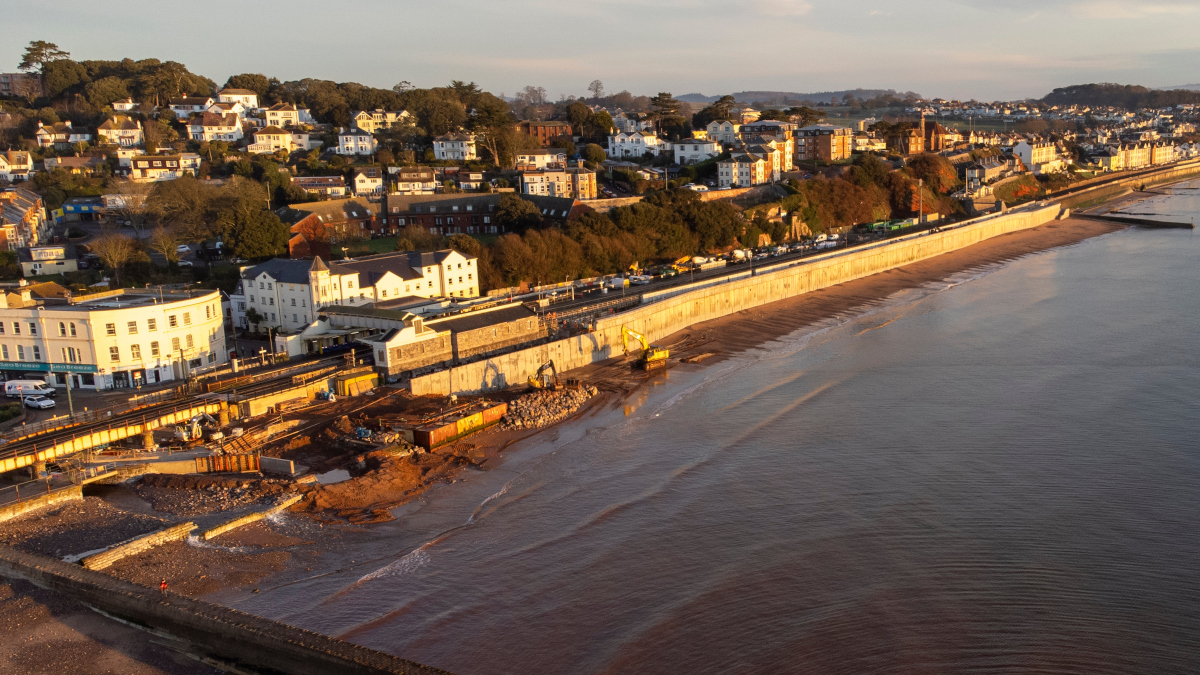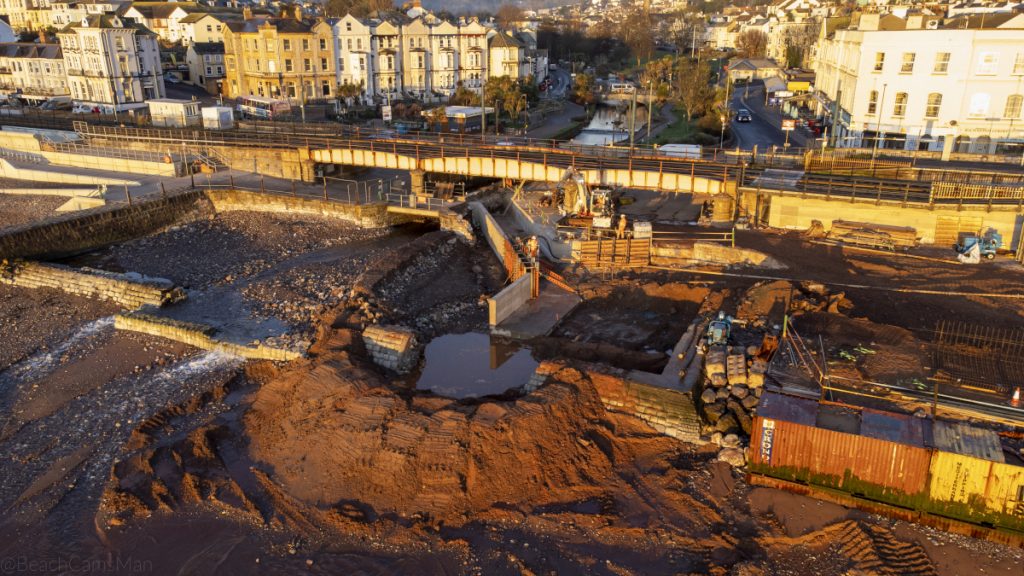Breaking waves in Dawlish – new sea wall playing key role in protecting town and railway

Eight years today (Friday 4 February) since the infamous 2014 storm severely damaged the railway on the South Devon coastline, Network Rail’s new sea wall project is making excellent progress and having a tangible and positive impact on the town and railway.
Since the start of construction on the first section of new, bigger sea wall in May 2019, the Dawlish coastline has undergone a mighty transformation.
The first section of new sea wall – which runs for 360 metres along Marine Parade south west of Dawlish station – was completed in July 2020 and construction of the 415 metre second section – stretching from Coastguard breakwater east of Dawlish station to Colonnade breakwater – began in November 2020.
Work on this second section is progressing well with Network Rail’s contractors BAM Nuttall having successfully installed all 143 concrete wall panels and curved wave returns on top of the panels that form the stretch of wall between the station building and Coastguard breakwater.
The innovative design of the wall panels and curved wave returns, coupled with the increased height of the wall, is having a noticeably positive impact keeping the tracks flood-free and train services running on this iconic stretch of railway.
The promenade along the second section is starting to take shape and the steps down to the beach at Coastguard breakwater have been completed, with Coastguard’s footbridge expected to reopen later this month.
The new sea wall is also benefitting from the latest in construction technology, with low carbon concrete being used as part of the concrete backfill, reducing the carbon impact of this project by two-thirds.
While excellent progress has been made, there is still a lot of work to do, and engineers are now focussing efforts on temporarily diverting the Dawlish river water as part of work on the new stilling basin and continuing installing the remaining piles between the stilling basin and the station building.
Work is also underway to completely rebuild the seaward platform 1 (serving trains towards Teignmouth) and resurfacing the landward platform 2 (serving trains towards Exeter) with a team of engineers working around the clock over four consecutive weekends in February to complete this work, making it safer and easier for passengers to step onto and off trains.
GWR is asking those intending to travel during this period to plan ahead and check journey times before travelling.
It is anticipated that the promenade along the second section and between the first and second sections of sea wall will be completed and open to the public this summer, meaning residents and visitors alike will be able to walk between Dawlish and Dawlish Warren along the entire length of new sea wall.
The overall £80m Department for Transport-funded project – which will also see improvements made to Dawlish station including an accessible station footbridge with lifts – will be completed in 2023 and will protect the railway and town from rising sea levels and extreme weather for future generations.
Rail Minister, Wendy Morton, said: “The progress being made on Dawlish’s sea wall is incredible. We are investing £80 million to rebuild this iconic station, as well as making it more accessible for all passengers.
“As extreme weather events become more common, we must do all we can to protect our transport network.
“Investing in our railways is essential to levelling up the country and ensuring local economies can flourish.”
Julie Gregory, Network Rail senior sponsor, said: “It is brilliant to see the progress being made on the second section of sea wall in Dawlish and how it is really starting to take shape.
“I’ve been mightily impressed with the transformation of this stretch of coastline which is testament to the hard work and dedication of our team of engineers and contractors BAM Nuttall.
“This is a really significant project – not just for Network Rail but for Dawlish and the entire South West peninsula – because once complete this new, bigger sea wall will play a central role in protecting this town and this key railway route to the south-west from rising sea levels and extreme weather for generations to come and, we hope, prevent the events of 2014 ever happening again.”
Yan Sayles, BAM Nuttall Project Manager said: “Dawlish has been a job like no other. The location of the railway, sandwiched between the sea and the town, has made delivering the work incredibly challenging but enormously rewarding. It has pushed us to the limits of our knowledge and required us to develop new techniques and materials that have never been used in other rail projects before.
“I’d like to thank the residents of Dawlish for their patience, hospitality and friendship over our years delivering this work. We know our work has sometimes caused noise and disturbance, but we hope that it will provide a lasting legacy which will benefit the town for many years to come. BAM and our suppliers are extremely proud of the work we’re delivering in Dawlish and I’d like to express my gratitude to everyone who has contributed to the effort so far.”
Councillor Jonathan Drean, Chair of Peninsula Rail Task Force, said: “The resilience and reliability of the mainline at Dawlish remains the top priority of the Peninsula Rail Task Force and therefore it is heartening to see the tremendous progress being made along the sea wall.
“Completion of this programme of works is essential to increasing business confidence, attracting inward investment and supporting communities, tourism and economic growth right through the South West to South Devon, Plymouth and Cornwall.”
Councillor Val Mawhood, Mayor of Dawlish, added: “The great storm of 2014 is now a major part of Dawlish history and something that will be spoken about for generations to come.
“This awful event showed just how vital this section of the rail network is for the whole of the South West and I welcome the progress which has been made on the new sea wall. This is already having a positive impact on the town and will ensure that history isn’t repeated.”
Mark Chorley, GWR Regional Station Manager, West, said: “This work is important to ensure we can continue to maintain and improve resilience and we thank customers for their patience in advance.”
“We have been working hard to provide as many replacement buses as we can to ensure people can continue to travel confidently and safely. However, we strongly recommend our customers check their times carefully before travelling to ensure a smooth journey with us.”
Throughout February, the Dawlish Information Hub, situated on Marine Parade, will be open to the public on Saturdays between 12 and 2pm.
The new sea wall at Dawlish is part of Network Rail’s ongoing efforts since 2014 to improve the resilience of the railway between Dawlish and Teignmouth in Devon, known as the South West Rail Resilience Programme (SWRRP).
For more information and to follow the latest developments, please visit https://www.networkrail.co.uk/running-the-railway/our-routes/western/south-west-rail-resilience-programme/dawlish-sea-wall-section-two/

